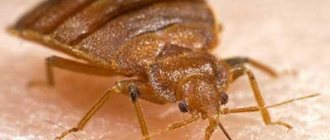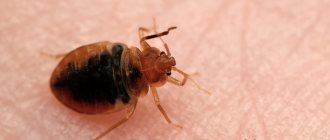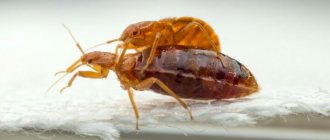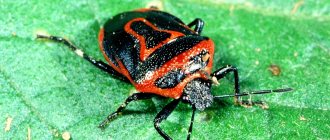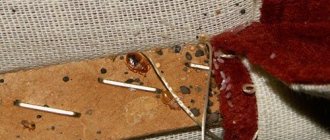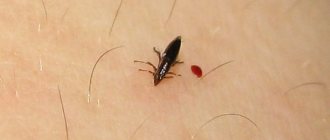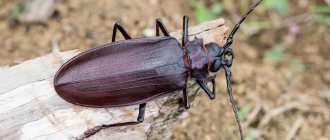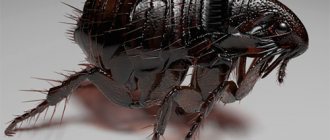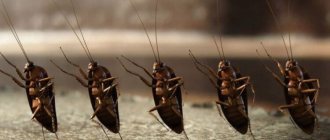Bedbugs are currently one of the most important problems of modern society, and for many city residents they are an inevitable, expensive and painful problem. In Russia, bed bug infestation in city apartments is worsening every day, so it is not surprising that in the regions of the country this is a fairly common phenomenon.
And in New York, the parasite infestation is considered a full-blown epidemic. It's so bad that at the beginning of the year a summit was held to combat bed bugs in city apartments. Blood-sucking bugs will not destroy you, but they can drive you crazy (they affect the human psyche): it is impossible to sleep in your own apartment, cozy houses turn into dangerous places, the night is terrifying and many victims of bed bugs cannot get rid of the fear of parasites.
Bed bugs reproduce at an incredibly fast rate. One female can lay from 4 to 10 larvae per day and approximately 500 eggs over the entire period of life, and her relatives can reproduce themselves within a month. In a week, these insects are able to inhabit a 2-room apartment, in a month, the 1st floor of an apartment building, and in six months, a 5-story panel building.
Description
Despite the huge species diversity, bedbugs have similar features:
- number of limbs: adults have three pairs of limbs, they can be of different types, adapted for life on land or in water;
- oral apparatus in the form of a proboscis and bristles: the bug feeds on liquid food, it pierces the shell and sucks out the contents, be it blood or plant sap;
- glands that secrete an odorous substance that is designed to repel enemies;
- wings - most species have them, they have a certain appearance: half of the wings are leathery, the other half are membranous; There are also representatives of the family that have only elytra or have completely lost their wings as unnecessary.
Bedbugs come in different sizes - from a couple of millimeters to 15 cm. The largest representative of the family is the water bug, which grows up to 15 cm in length. The shape varies, but most of the individuals are round, with a flattened body in a chitinous shell. Round or rod-shaped forms are also found. Not all bedbugs have eyes. But the organs of touch are well developed in all varieties.
Bedbugs come in different colors. Bright colors for those who are better left alone. It is a protection and a method of intimidation. Another means of protection is a pungent, unpleasant odor, which is caused by cimicic acid. Bedbugs secrete secretions from their glands. It is this smell that animals and birds that might eat bedbugs do not like.
What they look like
The body shape of most bugs is adapted to the living conditions, so it can be different. Bed bugs differ:
The bug is a harmful turtle.
- flat - parasitic creatures that become round after saturation;
- spherical - these are representatives of the family of earthen shields and desert ones;
- rod-shaped - a separate species, which includes Ghilianella filiventris;
- harmful turtles.
Some species are less than 1 mm long, and the largest reach 15 cm. Females are always larger than males.
The color of these insects can be of 2 types: repellent and display. All parasites, as well as those species with poorly developed odorous glands, have protective colors. Bright colors, which combine red, blue, green and black, are herbivorous species that have no enemies in nature.
Types of bedbugs
Depending on their habitat, bedbugs can be terrestrial or aquatic, indoor or outdoor.
According to their feeding method, the following types of bedbugs are distinguished:
- Herbivores (phytophages) - eat cell sap, which is obtained from the fruits, seeds and leaves of various plants.
- Predators – hunt larvae, insects and invertebrates.
- Ectoparasites (hematophages) - feed on the blood of people and warm-blooded animals.
The vast majority of bedbug species are herbivores. There are insects with a mixed type of nutrition. There are frequent cases of cannibalism, that is, eating their relatives.
According to the danger and harm caused, representatives of the genus are divided into useful, harmless and pests. They are generally harmless to humans.
Interesting facts about insects
The first record of a bedbug was found in chronicles of the 400s. BC e. Aristotle claimed that these insects could cure the effects of a snake bite and get rid of ear infections. In the 18th century, bedbugs were used for medical purposes as a remedy for hysteria. In the 19th century began to invent ways to combat parasites - “bug cookers”, rubbing with perfume and even special spells.
In Thailand, large water bugs are a tasty treat offered to tourists in expensive restaurants and street stalls.
Predatory bugs Acanthaspis petax hunt ants, whose skins they wear on their backs. A kind of shield scares away spiders, which will never attack ants that have accumulated in large numbers.
The water bug Micronecta scholtzi is capable of producing a sound with a volume of up to 99.2 dB, which is comparable to the roar of a moving locomotive. Males chirp to attract females. To do this, they scratch their belly with their genitals. However, a person does not hear these sounds, because all the action takes place under water.
Beneficial bugs
Some types of bedbugs can be quite beneficial. For example, the wingless red bug, also called the soldier bug, feeds on the remains of dead invertebrates or fallen leaves, contributing to their decomposition. The blue zikron bug destroys the larvae and eggs of leaf beetles. Thanks to its activities, the number of Colorado potato beetles is reduced. Also destroying the Colorado potato beetle, including its imago, is the perillus bug. Several species of flower bugs eat aphids, mites, eggs and larvae of harmful insects, and they are even bred specifically to protect seedlings and flowers grown indoors.
How to determine the type of bedbug
There are two ways to determine the type of bedbugs in your apartment.
The first is to turn to professional exterminators who have enough experience to find out who is in front of them. Also, an experienced specialist in the disinfection field is always up to date with the latest news on the prevalence of a particular species in your city.
The second is to contact a specialist (entomologist), since recently scientists have been doing a lot of work to identify new species, studying the biology, morphology, and behavioral reactions of newly emerged bedbugs. An example is the scientists at the University of Florida.
In principle, even if you haven’t determined what type of bedbug lives in your home, it doesn’t matter. Many exterminators use the same methods for exterminating bedbugs, and also use the same chemicals to kill them.
Pest bugs
Pests from the class of garden bugs are well known to gardeners and gardeners:
- Cruciferous and rapeseed - destroy plantings of cabbage, rapeseed, turnips and radishes.
- The berry bug, or light green stink bug, feeds on the juice of raspberries, gooseberries and other berries and can also infect cereal crops. Berries affected by this bug acquire an unpleasant odor and cannot be eaten.
- The tortoiseshell is a pest that is difficult to notice on plants due to the color and pattern on the shell; it attacks cereal crops. Turtles lay eggs, from which larvae emerge during the ripening period of the crop. Larvae and adults damage the grain, which becomes unsuitable for processing.
Chemical means to control bedbugs
- Aerosols are effective against bedbugs, but are dangerous for humans. You need to spray strictly on insects, wearing a respirator and a protective suit. After the procedure, wash your hands and face with soap. Popular remedies: Dichlorvos, Tetrix, Insecticide, Executioner.
- The powders kill insects within three days. The dust is destructive to adults and nymphs, but has no effect on bedbug eggs.
- Pencil crayons are not dangerous to humans, but they only repel insects and do not destroy them. Clean House, Titanic and Mashenka will make it clear to the bedbugs that they are not welcome here if they happen to drop by for a visit.
It will not be possible to eradicate a large population of ectoparasites on your own. The struggle takes time and effort, toxic substances affect people living in the apartment, and money is spent on purchasing drugs that will never give the desired result.
A pest control specialist identifies the habitats of insects, determines the size of the population and competently uses the optimal long-term exposure drugs.
Bring in the fog
Using special equipment, the exterminator creates cold and hot fog. The chemical, in the form of a cloud of steam, fills the apartment, making its way into the most secluded corners. During the spraying process, all adult bedbugs immediately die, and after disinfection, the substances act for about a month and bring death to the new generation that hatched from the moment the “fog” was sprayed.
Water bugs
Many species of hemiptera have chosen water as their habitat. The most famous types of water bugs are:
- Water scorpion - this family includes more than 200 species of bedbugs. Their length reaches 4.5 cm. They are brown, with forelimbs that have transformed into claws. They live in shallow water and cannot swim. They breathe through the tail appendage, which is placed above the water. They hunt tadpoles and crustaceans.
- Water striders are the largest family, which includes more than 700 species. They have long limbs on which they glide through the water. They feed on insects that have fallen into the water. They overwinter in fallen leaves outside water bodies.
- Smoothies live in water, but can also fly. They feed on insects and small fish; they can bite animals or humans, but the bite is not dangerous.
- Plautus vulgaris - feeds on insects, larvae, mollusks and fry.
- Belostoma gigantica - the bug got its name for its size; adult individuals reach a length of 10 cm. They can attack not only insects, but also fish and turtles. Not found in our country.
Features that bedbugs have in common:
- the body can be round, flat or rod-shaped, and may resemble the appearance of an apple seed. Sometimes there are bugs that look like tiny turtles. The body shape of insects can be determined by their habitat or the environment in which it was formed;
- each type of bedbug at the same stages of development (egg - nymph - adult) has approximately the same shape and color;
- The body size of bedbugs is usually 1 – 15 millimeters and is determined by the age and gender of the insect.
Ground bugs
Bedbugs live in different conditions. They live in the ground, grass, bushes and trees. They can live in any climatic zones, in forests and fields, in deserts and steppes, even in the tundra. Many people choose houses or other heated structures for their existence, for example, a barn or a poultry house.
Among terrestrial species, stink bugs are the most common. They got their name because they look like they have a shield on their back. They are also called tree bugs, although they do not only live on trees. There are more than 4 thousand species of stink bugs, most of them are agricultural pests.
Lined scale insect has a red-black color, it is striped and very bright, it eats the inflorescences of carrots, parsley and dill.
The berry shield bug is red-brown in color and eats berries, leaves and buds of oilseeds and fruit crops.
Shield bug – more than 50 species of bugs are known by this name. Destroy cereal crops.
Marbled bugs feed on different types of plants. They are highly fertile and have almost no natural enemies. They winter in houses.
Common questions about bedbugs
Is it enough to throw away a sofa in which bedbugs live to get rid of them?
No. Most likely, insects have inhabited not only the sofa. Of course, if the sofa is old and riddled with bedbugs, you should throw it away, but to be sure that the insects will not sit under the baseboards or behind the closet waiting for a new sofa, it is worth treating the room.
What temperature kills bedbugs?
A temperature of +50°C almost instantly kills bedbugs at all stages of development. Adults die at temperatures below -20°C and above +45°C. The larvae die at -17°C.
Is it possible to accidentally bring a bedbug home?
Yes. Bloodsuckers may accidentally come to you along with someone else's household appliances or upholstered furniture. Since purchasing used items always carries a risk of infection with bedbugs, they should be treated with an insecticide before bringing them into the apartment.
Can bedbugs live inside an orthopedic mattress?
The size of the insect does not allow it to penetrate inside the mattress. But if the cover is torn or has holes, the bug will infest all layers of the mattress.
In what cases do bedbugs appear again after treatment?
- if the insecticide was chosen incorrectly and live insects remained in secluded places;
- if your neighbors’ apartment is infested with bedbugs and they don’t poison them;
- if the eggs were not killed, young larvae will hatch from them 5-7 days after treatment
This is why treatment against bedbugs often has to be repeated 2-3 weeks after the initial extermination.
If you need a guaranteed result, call the phone number listed on the website or fill out the feedback form. The company’s specialist will advise you on the exact cost of the service and book a specialist visit on a date and time convenient for you.
We are ready to promptly exterminate hated insects 24 hours a day, seven days a week!
House bugs
Blood-sucking bedbugs are dangerous to humans. There are several dozen species of domestic ectoparasites. They are all small and flat. When saturated with blood they increase several times. They don't have wings, but they have running legs. House bugs have a flattened oval body and are yellowish or brown in color. There are no eyes, the sense of touch and smell are well developed. The size of the larva is from 1 to 4 mm, the adult is up to 6 mm.
Insects hide inside furniture, in cracks and crevices. They can migrate from apartment to apartment or to neighboring buildings. They are active at night.
Although such bugs are called bed bugs, they live not only in human homes and feed not only on human blood. Species are known that settle in caves where bats live. There are also so-called swallow bugs. They parasitize birds, but can also migrate to humans.
Bed bugs live everywhere, in all countries. Their distribution does not depend on social status, level or lifestyle.
There are types of bed bugs that are not so common and do not live in our country at all:
- stinging bug - its bite causes severe allergic reactions;
- triatomine bug - after a bite, anaphylactic shock can develop, and these parasites also carry Chagas disease, which is fatal.
These types of bedbugs live in countries with hot climates and do not pose a danger to us, but we must remember them when traveling.
There are three types of house bugs in Russia:
- Cimex lexctularius is the most common, common blood-sucking bug with a specific odor, feeds on human blood, and prefers to bite children due to the close proximity of the blood vessels to the skin; can fast for a whole year; the development cycle from egg to adult takes from 30 to 100 days;
- Cimex pipistrelli – parasitize bats;
- Oeciacus hirundinis is the same swallow bug mentioned above; parasitizes birds, can attack humans, and is a carrier of diseases.
Methods for detecting bedbugs in an apartment or house
To detect a bedbug, you need to know the places where it can hide. The search begins with an inspection of sofas and armchairs, bed linen, and mattresses. You should check the linen closet, bedside tables, and electrical appliances. These parasites also live under carpets, baseboards, linoleum, parquet floors, flower pots, and between books.
To confirm the presence of bedbugs, you can do the following manipulation: make a solution from a bucket of water, a few drops of alcohol, a decoction of wormwood, tansy or 9% table vinegar. Moisten the floors and baseboards with the resulting mixture. After this, the insects will immediately begin to leave their homes.
Harm from bed bugs
A domestic bug lives on average 12 – 14 months. Eats once a week. A bug nymph can suck up to 0.5 ml of blood at a time, and an adult can suck up to 7 ml. All bed bug bites cause itching, redness of the skin, and a rash. Moreover, a person may not notice the moment of the bite, since the parasite injects an anesthetic substance during the bite.
The danger with bed bugs is that they are difficult to get rid of. They settle in large colonies in an apartment or house and plague residents with constant bites. This leads to severe psychological discomfort. In terms of health, there is no great harm from bedbug bites. But they can cause allergic reactions. Bedbugs can also act as carriers of diseases if they migrate between rooms. In addition, blisters from bites are very itchy, scratching them can introduce an infection into the wounds, which leads to skin diseases.
Domestic bugs are sensitive to changes in living conditions. The most comfortable temperature for them is 25 – 30 degrees. With a sharp increase (more than 45 degrees) or decrease (freezing), they die. But at the same time, these insects are becoming increasingly resistant to the means used to combat them. People have to invent new compounds to chemically kill bedbugs.
Lifespan and habitat
Despite its name, bed bugs do not live in beds. Insects choose dark places in the vicinity of the victim, where no one will disturb them. They are nocturnal, making them difficult to detect. During the day, these parasites sleep, pressing both their backs and bellies to the surface of the furniture.
Bedbugs most often form nests in the following places:
- in parts of the mattress that are adjacent to the bed frame;
- in the folds of furniture upholstery;
- between the headboard and the wall;
- behind loose wallpaper, wall hangings;
- between the battery and the wall;
- in bedside tables;
- in cabinets, incl. book;
- in floor cracks or baseboards.
The more parasites there are in a room, the wider their habitat. If there is a heavy population, pests can live in adjacent rooms. These insects move quickly, so they can get to the feeding site without any problems.
The life of a domestic insect is directly related to humans and the conditions available in the room - warmth and low air humidity. Temperatures affect the lifespan of the parasite without food. If the room is cool, the insect can survive up to 1 year. At high temperatures, metabolic processes accelerate, which shortens the life of the parasite. At average temperatures, bedbugs can live 14-15 months.
7) Nightstands
Almost always, next to the bed or sofa on which a person sleeps, there is a bedside table or chest of drawers. Bedside furniture is a favorite place for bedbugs to hide during the day. Insects quickly move there directly from the bed or sofa, comfortably placing themselves in the unlit interior space.
You can find a bug anywhere on the bedside table, but you should especially carefully examine the joints between the individual parts of the product - shelves, walls, ceiling and floor. In order to find parasites, you will need to remove all the objects located inside the furniture and carefully inspect all the listed places.
6) Chairs and tables
Wood, especially untreated and not coated with any varnish, is rightly considered one of the most “favorite” materials for bedbugs. Tables and chairs are often made from it. In this case, they can and are highly likely to become places where insects hide. Especially if a chair or table is installed next to the bed.
In addition to the joints of wooden parts, parasites also use the upholstery as a hiding place, as well as the places where the fabric joins the chair frame. It is also necessary to carefully inspect the furniture for defects in various surfaces and the structure as a whole - potholes, cracks or crevices. These places also often attract parasites and are used by them for daytime stay.
5) Bedding
A variety of bedding - linen, pillows, blankets - are rarely used by bedbugs for daytime shelter. Typically, parasites are found on these objects at night during the active phase of their lives. They prefer to hide in more secluded and inaccessible places.
But it is important to take into account the fact that this applies to cases where there are relatively few bedbugs. If the situation becomes dire and the number of parasites goes off scale, they can be found literally everywhere, including bedding. Naturally, in this case, emergency measures are required, and the main task is not to detect insects, but to choose the most effective methods of exterminating them.
3) Mattress
The most popular place bed bugs use as a hiding place is, without a doubt, the bed. Moreover, you can consider it as three separate subjects, describing each of them in more detail. The first is the mattress. It is there that bedbugs hide first, since this ensures the reliability of the shelter and the proximity of its location to the “hunting” grounds.
Parasites are especially often located on the lower edge of the mattress and in all seams of the product. The only advantage of such a bedbug shelter, if their presence can be accompanied by any advantages at all, is ease of detection. In the vast majority of cases, mattresses are upholstered with light-colored fabric, on which traces of insect activity are clearly visible. In order to identify them, simply remove the bed linen, turn over the mattress and carefully inspect it.
Where do bedbugs like to live?
Bedbugs are very tenacious. It’s hard to imagine how many places they are ready to explore in a short time.
Below is a short list of the favorite places of residence of nocturnal bloodsuckers:
- Seams, folds of mattresses, box springs, sofas and all other furniture.
- Bedding, pillows, bed skirts, etc.
- Cracks in bed frames, chests of drawers or wood furniture, plaster or any other surfaces
- Curtains and other folds of fabric
- Cloth
- Behind wood molding (if there are cracks)
- Carpet edges
- Under the rugs
- Electrical sockets
- Knots in wooden furniture
- Screw heads
- Any items hanging on the wall, such as mirrors or picture frames
- Stuffed Toys
- Items stored under the bed
- Electrical appliances
11) Paintings and carpets
In one of the previous paragraphs, the “love” of bedbugs for fabric materials that are used for sewing drapes, curtains and curtains was described. All of the above fully applies to carpets and paintings, in which parasites hide no less willingly. In the vast majority of cases, they are located on the back side, but they can also be located outside if the total number of insects becomes large.
As a rule, it is quite easy to detect parasites in these places. To do this, you need to peel back the carpet or move the picture away from the wall, and then look at the inside of the object. Particular attention should be paid to those that are located in close proximity to the bed or sofa that a person uses to sleep. This type of shelter is used most often by parasites, as it provides them with the opportunity to quickly reach the object of their “hunt” after dark.
